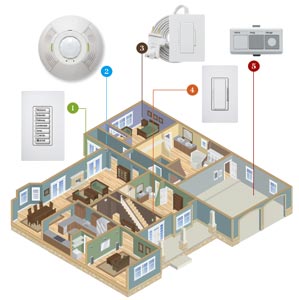Lighting Control
A lighting control system can automatically dim your lights, enact preset “scenes” so only the fixtures you need come on, automatically turn on and off lights so you don’t have to run around the house to do so- and interact with other home systems such as motorized window shades, security systems, thermostats, and whole-house control and automation systems.
There are many types of systems available, in a variety of configurations and price points. You can have a fully wired system if you’re building a home or addition. If not, no worries: Opt for a wireless system that transmits commands over radio frequency signals instead of wires. A combination of the two works for many homeowners.

Many lighting control systems today incorporate motion and occupancy sensors to turn on and off lights automatically. And some lighting systems are starting to work hand-in-hand with shading and thermostats. Lutron, for example, offers this seamless integration in its wired HomeWorks QS and wireless RadioRA 2 systems. If a sensor detects too much sunlight coming into a room, or if the temperature exceeds a certain point, the shades can automatically descend. Conversely, the shades can open to harvest daylight and warmth from the winter sun, while triggering lights to turn off.
Convenience is king, but lighting control systems today offer much more.


Whole-house lighting control systems are available from companies including Lutron. Also available are a variety of lighting control products that employ wireless Z-Wave and ZigBee technologies.
The diagram to the left illustrates possible locations for the various components that make up a lighting control system.
TYPES OF LIGHTING:
LEDs
Light emitting diodes are the new big thing, but LED lamps can be expensive, so it’s hard to replace all your lights with them at once. Buy a few at a time, and make sure they have enough brightness (expressed in lumens). A 60-watt incandescent bulb, for example, throws about 850 lumens.
Incandescent
Incandescent bulbs started being phased out in the United States in 2012 with 100-watt bulbs. About 90 percent of the energy used to illuminate an incandescent bulb is wasted as heat. So either looks into other energy efficient alternatives or make sure you dim your incandescent bulbs to save electricity.
CFL
Compact fluorescent lamps have improved greatly, but many of them can’t be dimmed. Use them in areas where lights will be left on for a while, as they often need time to warm up. Seek color temps in 2700 to 3000K (Kelvin) range for a “soft light” resembling that of an incandescent bulb.
Halogen
Halogen bulbs can be slightly more efficient than incandescent bulbs (efficiency varies), and they emit a light that is as visually pleasing to the eye.
THINGS TO CONSIDER:
Outdoor lighting
Put outdoor lights on an astronomical timer so that they turn on automatically at dusk. The astronomical timer adjusts the settings to coincide with the changing daily sunset times.
Photocell Sensor
Place these near motorized window treatments to read how much natural light is entering a space and to trigger the opening or closing of shades or drapes to harvest daylight.
Lighting System Processor
A lighting control system often requires the main processor, or several processors, which are typically located in a basement or equipment room. Some wireless lighting control systems also require processors.
Wireless Repeaters
These are often needed to ensure that commands sent by a wireless lighting control system are transmitted reliably. They are placed in various locations.




